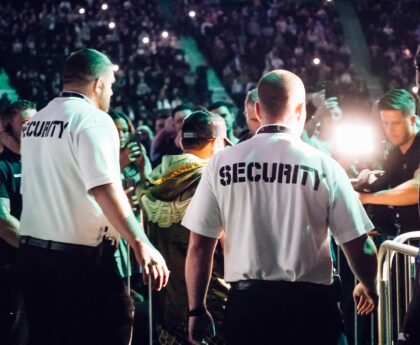Event security has evolved well beyond the standard uniformed officers, access control and incident response. Today’s event security professionals are strategists who use intelligence driven risk-based models to mitigate threats by identifying and addressing gaps and vulnerabilities. Successful event security planners practice a holistic approach combining physical protection of people and property, from obvious threats of terror and violence, along with the subtle art of protecting brand and reputation. Such an approach necessarily includes protest planning. If not managed properly, a protest can not only upstage your event but may become the only event that anyone will remember.
Activism of all stripes is on the rise as our increasingly polarized and partisan society seems driven by growing socio-economic and political disparities. Special events act as a magnet to those who seek a prominent stage where they can showcase their cause and maximize their audience. Recent media reporting is filled with examples of protests that become the headlines at corporate, academic, sporting, political and other events.
In April 2018, the Wells Fargo annual shareholders meeting drew the attention of angry protestors in Des Moines, Iowa. Despite the scandal plagued bank’s practice of keeping its meeting location close to the vest until the last minute, protestors still learned of the location and showed up in force. Chants of “Wells Fargo you’re the worst, put people and the planet first” were heard throughout the lobby of the Marriott hotel hosting the meeting. Protestors playing plastic trombones added to the din.
Amazon’s annual meeting in May 2018, was described as a “carnival atmosphere” due to a colorful and distracting array of protestors from drag queens demanding Amazon select a headquarters location in a “gay rights” state, to cargo pilots picketing over insufficient staffing, to corporate activists carrying giant puppet signs depicting CEO Jeff Bezos, all while the Rev. Jesse Jackson delivered a message against the company.
In September 2017, the University of California at Berkeley became the sight of nine arrests as one thousand protesters assembled to oppose a campus lecture by Ben Shapiro, a right-wing author and political commentator. Security costs for this event approached $600,000.
Contingencies for both planned and unplanned protest are too often absent from event security company. Even when protest planning is included key some elements are left out or inadequately addressed.
What are the Top Ten things to do if there is a protest at your event?
Know What You Are Up Against
Begin by conducting a thorough threat assessment. This starts with gaining a deep understanding of the client, the venue and the participants so you can then understand the related threat and risk to the actual event. Through interviews with stakeholders, police intelligence units, and on-going Open Source and Deep Web Intelligence, assess the history and issues inherent with the event, keynote speakers, guests, hosts, sponsors, venue, neighborhood, event date, nearby events and stakeholders to develop a risk ranking for potential protest or other disturbance.
Ranking risk involves quantifying and qualifying both the likelihood and the impact of foreseeable incidents. For example, you may determine that there is a disgruntled former employee of the sponsor who could try to disrupt the event by handing out leaflets outside the event. You might determine that there is a low probability that this person will do this because he will be out of town on the day of the event. You might also determine that even if this person does hand out leaflets the impact will be quite low. You would appropriately assign this risk a low priority in terms of your resources and effort. Conversely you might also learn of a high probability that an activist group will block the entrance to the event and that such an action would have a high impact on the event. You would place a high priority on devoting resources and planning to mitigate and address this risk.
Communicate Proactively with Protesters and Activist Groups
If you identify individuals or groups intending to attend and potentially disrupt the event you may want to coordinate a strategy to communicate with the suspect individual or with the leaders of the group. First, gain the concurrence and support of the event host or sponsors. Seek out the smartest approach to the group which may involve either direct or indirect communications. Assess whether you should partner with the host, sponsor, venue or police in your initial communication. The presence of those parties may exacerbate tensions and undermine your attempts to open a channel for dialogue but could also be perceived by protest leaders as a genuine opportunity to air their grievances and deescalate the stress level. Once protest leaders view you as a security professional who respects their freedom of speech, and understands their issues, they are likely to be receptive to a mutually beneficial plan that facilitates their expression while ensuring a successful event.
Consider Community Activist Liaisons
Our team utilized to great benefit Community Activist Liaisons (CALS) for a series of client events we identified as prone to significant protest. Respected individuals, well known in the protest groups were on-boarded to overtly act as conduits between special event security and the protest groups to better communicate each party’s goals, objectives and concerns. This involves a level of trust and risk, but transparent sharing of intentions leads to successful outcomes. These CALS can be used to help foster the concept that successful protest and successful event are not mutually exclusive. CALs can be used to help enforce designated, agreed upon protest areas or to communicate changes in previously arranges accommodation.
Adapt Physical Security Measures to the Threat
There are multiple and intrinsic considerations in relation to the design of security including stage set-up, VIP movement, stanchion layout, access control, credentialing, green room security, traffic flow and emergency preparedness (e.g. fire). All of these must be adapted to best manage and mitigate the risk of protest. If a protest that blocks access is planned, discuss legal options with local police commanders and develop alternate access to the venue. If protestors are adamant on displaying offensive signs or chanting obscene phrases, consider parking buses between the protestors and the event entrance or piping in music to mask the chants.
Have Contingency Plans
Lots of things can and will go wrong. The event security professional engages in predictive analysis based on sound intelligence, experience and planning. Once threats and risks to the event are identified mitigation measures must be implanted. The mitigation spectrum is broad and may include measures as diverse as re-routing a VIP vehicle to a rear entrance, to having a unit of riot police on standby.
React Proportionately
Understand and strategize a specific response continuum for each event. This should look a lot like a “decision tree” that approaches various scenarios with the mindset of “if they do that, we do this”. Remember that aggression breeds aggression and that in an emotionally charged environment the slightest perception of elevated response can trigger unintended consequences. Don’t let yourself or your staff be the ones who escalate tensions. Select staff who grasp the importance of calm and measure response. A rehearsed response plan helps to ingrain instinctive conduct rather than actions developed in the heat of the moment.
Think Beyond the Physical
Your client or organization is paying you to protect more than just this event. Whether they know it or not, the success or failure of this event will reflect on your client’s brand and reputation. We live in a society where photos and videos of angry encounters, protest incidents and police actions are transmitted in real-time around the globe from smart phone to social media in an instant. Our 24/7 news cycle demands a constant feed of reporting on matters of local, national and international interest, and protestors use every tool at their disposal to promote their cause while smearing the image and name of their targets. Understand whether media will be present at the event and coordinate their access and seating while considering media escorts provided by the host or sponsor. Ensure your staff conducts themselves with a mindset of “Would I want this on tonight’s news?” and “How will this make our client look?”
Communicate With All Stakeholders
Event security is a team sport. Hospitality team members, Audio-Visual technicians, Stage crews, Volunteers, Transportation Coordinators, Ambulance crews and others should be viewed as your “eyes and ears” and should understand at least the concepts behind your plan. Just because you have a plan does not mean everyone is aware of it. Build relationships across components and view your team as part of the overall event team as opposed to a distinct security component. Implement redundant methods of communications for both routine messaging – “The guest speaker has arrived” – and for emergency communications – “A protestor has breached the back door”. Rehearse various scenarios with the key stakeholders.
Avoid Distractions
Like very young soccer players who all rush to the ball, even the most experienced security professionals can get bogged down and lose sight of the entire field when an incident occurs. Establish a self-discipline approach that allows you to quickly assess the priority of an incident or threat and to delegate to a trusted deputy when appropriate. This method allows you to deal with developments with an understanding of what requires your attention and to what degree. Have a plan to put a deputy in charge if you must address a significant issue for a protracted time.
Don’t Go It Alone
Today’s events require high-quality security, at a level commensurate with risk to physical and reputational safety. Once event hosts understand this they next need to understand the cliche’ of “You get what you pay for.” Event security professionals facilitate client logistics, liaise across multiple components including protest groups, police, fire and rescue personnel, and pro-actively mitigate risk. Clients have proven and will attest that investing in a small team of security managers and specialists to work alongside event teams, local uniformed security providers and stakeholders has been invaluable and provides a worthy return on investment.
Written by Mark Deane and Frank Figliuzzi and orginally published at https://www.securitymagazine.com/articles/89771-never-let-the-protest-become-the-event
Mark Deane, the CEO of ETS Risk Management is a risk management professional whose experience stems from his previous career as an Operational Officer with the British Government. He has planned, managed, and delivered numerous security and risk management operations at both a government and corporate level. He regularly delivers training to corporate and government agencies in a range of security, surveillance, and intelligence services.




